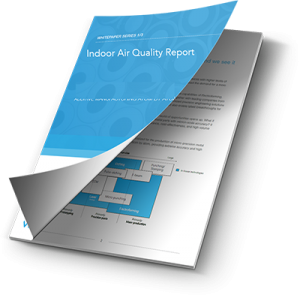01: Indoor Air Quality Audit
Why We Start With Indoor Air Quality Testing
Like any good problem solver our specialists need to first understand the facts and evaluate the situation before making any recommendations on indoor air quality solutions. That’s why at the beginning of every consultation we conduct a computerized indoor air quality audit that analyzes the air inside your home and reports on six different key metrics. Using those metrics our specialists are able to create a customized action plan that will be most effective at remedying your unique indoor air quality issues.
What Does The Test Measure?
The comprehensive report from your indoor air quality audit measures six key factors that frequently contribute to the problems caused by indoor air pollution. If any of the factors are at a level that can pose risk to your health, comfort, or safety, the report also identifies potential causes and recommended actions.
1. Particles
Particles are known to trigger asthma and allergy symptoms and can be caused by a number of things ranging from heating and cooling issues to certain activities happening in your home.
2. Chemicals
Also referred to as VOC (volatile organic compounds,) chemical pollutants are known to trigger asthma and allergy symptoms, eye and nasal passage irritation, nausea, headaches, and according to the American Society of Heating, Refrigeration and Air Conditioning Engineers; Health Canada; Washington Department of Health, at very high levels, they can even affect normally healthy adults by overworking the liver and kidneys.
Ironically, many of the chemicals present in our homes are emitted from products we use to take care of ourselves and our homes such as air fresheners, nail polish, cleaning products, paint, and glue. Your home’s building materials, furniture, carpeting, and HVAC system are all things that contribute to the level of VOCs you’re breathing inside your home.
3. Carbon Dioxide
Carbon dioxide at high levels, CO2 (carbon dioxide) inside a home can cause what EPA calls “sick building syndrome” which can be recognized by fatigue, headaches, difficulty breathing, nausea, strained eyes, and itchy skin. At even higher levels, CO2 can cause asphyxiation as it replaces oxygen in the blood. CO2 poisoning, however, is very rare.
Ironically, CO2 is produced from activities that are intended to make our homes more comfortable and energy efficient. Breathing, burning candles or wood, as well as he construction techniques used nowadays to create weatherized and energy efficient homes contribute to CO2 building inside the home.
4. Temperature
While uneven temperatures inside your home can be uncomfortable, they can also be a sign of a more serious issue caused by a poorly located thermostat, imbalanced ductwork, inadequately sized HVAC equipment, poor insulation, or inadequate weatherization.
5. Relative Humidity (RH)
Too much or not enough in-home moisture can create litany of problems for your health, comfort, furnishings, and your wallet. According to the ALA, relative humidity level in a home should hover around 45%. Anything outside of the 40%-50% range can lead to the common problems associated with air that’s too dry or humid.
Everyday things that can cause relative humidity to fluctuate includes structural issues like standing water in the basement, leaky faucets, inadequate ventilation in the winter, and possible heating and cooling issues such as inadequate humidification or ventilation, improperly sized cooling system. It could also be a warning sign that your HVAC equipment needs repair.
6. Carbon Monoxide
When people are exposed to relatively low levels of carbon monoxide, it can cause headaches and nausea. At relatively high levels it can cause memory problems and ultimately death. Carbon monoxide is known as the silent killer because it’s an odorless and colorless poisonous gas that’s comes from unexpected sources such a stove, gas dryer, combustion from fireplaces, cooking, or vehicles running in an attached garage.
Signs of Poor Indoor Air
The signs of poor indoor air can range from obvious to obscure, making it nearly impossible to accurately identify the real problem. Too often homeowners treat the symptoms of poor indoor air while spending time and money trying to fix the problem without ever really investigating. If you notice any of the below signs, find out for sure what the issues are, why they’re happening, and to resolve them:
- Fatigue
- Headaches
- Nausea
- Difficulty breathing
- Dry itchy skin, eyes
- Uneven temperatures
- Odors
- Cracked or warping wood
- Peeling paint
To request an indoor air quality audit, call our product specialists at (262) 735-5548 or submit the form at the top of the page.


